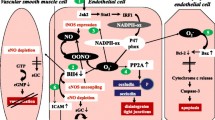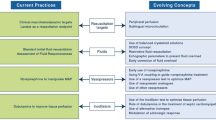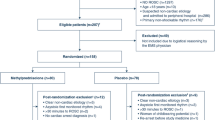Abstract
Endotoxin shock is characterized by systemic hypotension, hyporeactiveness to vasoconstrictors and acute lung edema. A nitric oxide synthase (NOS) inhibitor, NG-monomethyl-L-arginine (L-NMMA) has been shown to be effective in reversing acute lung injury. In the present study, we evaluated the effects of NOS blockade by different mechanisms on the endotoxin-induced changes. In anesthetized rats, lipopolysaccharide (LPS,Klebsiella pneumoniae) was administered intravenously in a dose of 10 mg/kg. LPS caused sustained systemic hypotension accompanied by an eightfold increase of exhaled NO during an observation period of 4 h. After the experiment, the lung weight was obtained and lung tissues were taken for the determination of mRNA expressions of inducible NOS (iNOS), interleukin-1β (IL-1β) and tumor necrosis factor-α-(TNF-α). Histological examination of the lungs was also performed. In the control group injected with saline solution, mRNA expressions of iNOS, IL-1β and TNF-α were absent. Four hours after LPS, the mRNA expressions of iNOS and IL-1β were still significantly enhanced, but TNF-α was not discernibly expressed. LPS also caused a twofold increase in lung weight. Pathological examination revealed endothelial damage and interstitial edema. Various NOS inhibitors were given 1 h after LPS administration. These agents included Nω-nitro-L-arginine methyl ester (L-NAME, 10 mg/kg), a constitutive NOS and iNOS inhibitor; S,S′-1,4-phenylene-bis-(1,2-ethanedinyl) bis-isothiourea dihydrobromide (1,4-PBIT, 10 mg/kg), a relatively specific iNOS inhibitor, and dexamethasone (3 mg/kg), an inhibitor of iNOS expression. These NOS inhibitors all effectively reversed the systemic hypotension, reduced the exhaled NO concentration and prevented acute lung injury. The LPS-induced mRNA expressions of iNOS and IL-1β were also significantly depressed by these NOS inhibitors. Our results suggest that NO production through the iNOS pathway is responsible for endotoxin-induced lung injury. Certain cytokines such as IL-1β are possibly involved. These changes are minimized by NOS inhibitors through different mechanisms.
Similar content being viewed by others
References
Archer S. Measurement of nitric oxide in biological models. FASEB J 7:349–360;1993.
Beutler B, Krochin N, Milsark IW, Luedke C, Cerami A. Control of tumor necrosis factor synthesis: mechanisms of endotoxin resistance. Science 232:977–980;1986.
Brigham KL, Meyrick B: Endotoxin and lung injury. Am Rev Respir Dis 133:913–927;1986.
Caput D, Beutler B, Hartog K, Thayer R, Brown-Shimer S, Cerami A. Identification of a common nucleotide sequence in the 3′-untranslated region of mRNA molecules specifying inflammatory mediators. Proc Natl Acad Sci USA 83:1670–1674;1986.
Chen HI, Hu CT. Endogenous nitric oxide on arterial hemodynamics: A comparison between normotensive and hypertensive rats. Am J Physiol 273:H1816-H1823;1997.
Chen HI, Hu CT, Chang KC. Characterization of arterial hemodynamics in rats with established hypertension. Chin J Physiol 39:49–55;1996.
Chen HI, Hu CT, Wu CY, Wang D. Nitric oxide in systemic and pulmonary hypertension. J Biomed Sci 4:244–248;1997.
Dinarello CA. Interleukin-1 and interleukin-1 antagonism. Blood 77:1627–1652;1991.
Dinarello CA, Wolff SM. The role of interleukin-1 in disease. N Engl J Med 328:106–113;1993.
Eduardo N, Palmer RMJ, Moncada S. Inhibition of nitric oxide synthesis in the septic shock: How much is beneficial? Lancet 338:1555–1557;1991.
Garvey EP, Oplinger GJ, Tanoury GJ, Sherman PA, Marshall MFS, Harmon MF, Paith JE, Furfine ES. Potent and selective inhibition of human nitric oxide synthases, inhibition by non-amino acid isothioureas. J Biol Chem 269:26669–26676;1994.
Grisham MB. Oxidants and free radicals in inflammatory bowel disease. Lancet 344:859–861;1994.
Gustafsson LE, Leone AM, Persson MG, Wiklund NP, Moncada S. Endogenous nitric oxide is present in the exhaled air of rabbits, guinea pigs and humans. Biochem Biophys Res Commun 181:852–857;1991.
Hamid Q, Springall DR, Riveros-Moreno V, Chanez P, Howorth P, Redington A, Boussquet J, Godard P, Holgate S, Polak JM. Induction of nitric oxide synthase in asthma. Lancet 342:1510–1513;1993.
Heiss LN, Lancaster JR, Corbett JA, Goldman WE. Epithelial autotoxicity of nitric oxide: Role in the respiratory cytopathology of pertusis. Proc Natl Acad Sci USA 91:267–270;1994.
Hu CT, Chang KC, Wu CY, Chen HI. Acute effects of nitric oxide blockade withL-NAME on arterial haemodynamics in the rat. Br J Pharmacol 122:1237–1243;1997.
Julous-Schaeffer G, Gray GA, Fleming I, Schott C, Parratt JR, Stoclet JC. Loss of vascular responsiveness induced by endotoxin involves theL-arginine pathway. Am J Physiol 259:H1038-H1043;1990.
Kilbourn RG, Gross SS, Jubran A, Adams J, Griffith OW, Levi R, Lodato RF. NG-monomethyl-L-arginine inhibits tumor necrosis factor-induced hypotension: Implications for the involvement of nitric oxide. Proc Natl Acad Sci USA 87:3629–3632;1990.
Liu S, Adcock IM, Old RW, Barnes PJ, Evans TW. Lipopolysaccharide treatment in vivo induces widespread tissue expression of inducible nitric oxide synthase mRNA. Biochem Biophys Res Commun 196:1208–1213;1993.
Lorente JA, Landin L, Pablo RD, Renes E, Liste D.L-arginine pathway in the sepsis syndrome. Crit Care Med 21:1287–1295;1993.
Marletta MA, Tayeh MA, Hevel JM. Unraveling the biological significance of nitric oxide. Biofactors 2:219–225;1990.
Michie HR, Manogue KR, Spriggs DR, Revhaug A, Dwyer SO, Dinarello CA, Cerami A, Wolff SM, Wilmore DW. Detection of circulating tumor necrosis factor after endotoxin administration. N Engl J Med 318:1481–1486;1988.
Misra HP, Fridovich I. The role of superoxide anion in the autooxidation of epinephrine and a simple assay for superoxide dismutase. J Biol Chem 247:3170–3175;1972.
Moncada S, Higgs A. TheL-arginine-nitric oxide pathway. N Engl J Med 329:2002–2012;1993.
Moncada S, Palmer RMJ, Higgs EA. Nitric oxide: Physiology, pathophysiology, and pharmacology. Pharmacol Rev 43:109–141;1991.
Nathan C. Nitric oxide as a secretory product of mammalian cells. FASEB J 6:3051–3064;1992.
Okusawa S, Gelfand JA, Ikejima T, Connolly RJ, Dinarello CA. Interleukin-1 induces a shock-like state in rabbits: Synergism with tumor necrosis factor and the effect of cyclooxy-genase inhibition. J Clin Invest 81:1162–1172;1988.
Parrillo JE. Pathogenetic mechanisms of septic shock. N Engl J Med 20:1471–1477;1993.
Root RK, Jacobs R. Septicemia and septic shock. In: Wilson JD, Braunwald E, Isselbacher JK, eds. Harrison's Principles of Internal Medicine, 12th ed. New York, McGraw-Hill, 502–507;1991.
Schulz R, Nava E, Moncada S. Induction and potential biological relevance of a Ca2+-independent nitric oxide synthase in the myocardium. Br J Pharmacol 105:575–580;1992.
Stewart TE, Valenza F, Ribeiro SP, Wener AD, Volgyesi GV, Mullen JBM, Slutsky AS. Increased nitric oxide in exhaled gas an early marker of lung inflammation in a model of sepsis. Am J Respir Crit Care Med 151:713–718;1995.
Szabo C, Mitchell JA, Thiemermann C, Vane JR. Nitric oxide-mediated hyporeactivity to noradrenaline precedes the induction of nitric oxide synthase in endotoxin shock. Br J Pharmacol 108:786–792;1993.
Thiemermann C, Wu CC, Szabo C, Perretti M, Vane JR. Role of tumor necrosis factor in the induction of nitric oxide synthase in rat model of endotoxin shock. Br J Pharmacol 110:177–182;1993.
Vliet AVD, Smith D, O'Neill CA, Kaur H, Darley-Usmar V, Cross CE, Halliwell B. Interactions of peroxynitrite with human plasma and its constituents: Oxidative damage and antioxidant depletion. Biochem J 303:295–301;1994.
Wang D, Hsu K, Hwang CP, Chen HI. Measurement of nitric oxide release in the isolated perfused rat lung. Biochem Biophys Res Commun 208:1016–1020;1993.
Wright CE, Rees DD, Moncada S. Protective and pathological roles of nitric oxide in endotoxin shock. Cardiovasc Res 26:48–57;1992.
Wu CC, Chen SJ, Szabo C, Thiemermann C, Vane JR. Aminoguanidine attenuates the delayed circulatory failure and improves survival in rodent models of endotoxin shock. Br J Pharmacol 114:1666–1672;1995.
Xiao J, Pang PKT. Does a general alteration in nitric oxide synthesis system occur in spontaneously hypertensive rats? Am J Physiol 266:H272-H278;1994.
Author information
Authors and Affiliations
Rights and permissions
About this article
Cite this article
Wang, D., Wei, J., Hsu, K. et al. Effects of nitric oxide synthase inhibitors on systemic hypotension, cytokines and inducible nitric oxide synthase expression and lung injury following endotoxin administration in rats. J Biomed Sci 6, 28–35 (1999). https://doi.org/10.1007/BF02256421
Received:
Accepted:
Issue Date:
DOI: https://doi.org/10.1007/BF02256421




